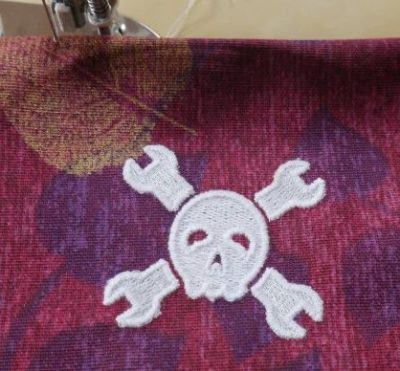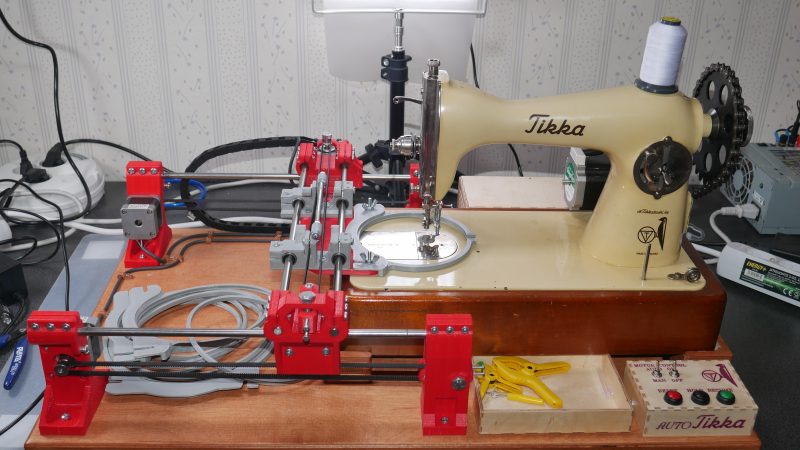It’s doubtful that the early pioneers of CNC would have been able to imagine the range of the applications the technology would be used for. Once limited to cutting metal, CNC machines can now lance through materials using lasers and high-pressure jets of water, squirt molten plastic to build up 3D objects, and apparently even use needle and thread to create embroidered designs.
 It may not seem like a typical CNC application, but [James Kolme]’s CNC embroidery machine sure looks familiar. Sitting in front of one of the prettiest sewing machines we’ve ever seen is a fairly typical X-Y gantry system. The stepper-controlled gantry moves an embroidery hoop under the needle of the sewing machine, which is actually the Z-axis of the machine. With the material properly positioned, a NEMA 23 stepper attached to the sewing machine through a sprocket and drive chain makes a stitch, slowly building up a design. Translating an embroidery pattern to G-code is done through Inkstitch, and extension to Inkscape. [James]’ write-up is great, and the video below shows it in action.
It may not seem like a typical CNC application, but [James Kolme]’s CNC embroidery machine sure looks familiar. Sitting in front of one of the prettiest sewing machines we’ve ever seen is a fairly typical X-Y gantry system. The stepper-controlled gantry moves an embroidery hoop under the needle of the sewing machine, which is actually the Z-axis of the machine. With the material properly positioned, a NEMA 23 stepper attached to the sewing machine through a sprocket and drive chain makes a stitch, slowly building up a design. Translating an embroidery pattern to G-code is done through Inkstitch, and extension to Inkscape. [James]’ write-up is great, and the video below shows it in action.
We’ve seen a CNC embroidery machine or two before, but our conspicuously non-embroidered hat is off to [James] on this one for its build quality and documentation. And the embroidered Jolly Wrencher doesn’t hurt either.
Thanks, [baldpower]!
















“It’s doubtful that the early pioneers of CNC would have been able to imagine the range of the applications the technology would be used for.”
Programming looms was literally the first use of punch cards. This was a key development for both computers and manufacturing automation. I’m sure the early developers of CNC technology would have been aware of this.
https://en.wikipedia.org/wiki/Jacquard_loom
Depends if they had an eye just for automating repetition, or infinite designs?
Computerized CNC machines came after embroidery machines. Not just the Jacquard loom which basically established punch cards that early computers used, but there are commercial embroidery machines that easily predate computers and computerized CNC machines. The Jacquard loom was the forerunner of good chunk of CNC, embroidery, and computer technology. The most standardized format for embroidery .dst has a command code that always ends with xxxxxx11 specifically because if you flipped the punch card over that becomes 11xxxxxx which is the command code for STOP, thereby preventing harm.
Some of the real efficacy here is actually running gcode rather than some of the rather intractable formats produced by embroidery companies. While CNC got standardized and got a lot of Computer Science TLC, embroidery got a conglomeration of different companies with their own format and their own controllers with literally no documentation anywhere. The real important element here is *any* inroads from any standardized code and methods.
Commercial embroidery machines have existed for decades. Home versions – as high end accessories to high end sewing machines – for more than 15 years.
An industrial embroidery machine is literally a two axis CNC machine, often with multiple heads.
This is remarkable for its DIY aspect and documentation, but not its concept.
Given the price of off the shelf embroidery machines, this might lead to an interesting price drop.
$305 seems reasonable for a new machine from a reputable company – https://www.amazon.com/gp/product/B07CCKSX2X
How much lower do you want the price to go?
Price is not always the issue, availability is. Also pricing policy is not always the same everywhere. AliEx and some old singers are literally everywhere. (trying to buy the machine from the link and get it shipped to spain, the price of the machine is increased to $448 + $1828 for shipping :)) and of course it is not available on amazon.es … it will of course not lead to a price drop, it is just cool someone did the work and now it can be made better (faster)
Quilts are real popular around here.
I won’t mention what my wife recently paid for a new “sewing computer” with embroidery capabilities. But, it was a lot.
My aunt has one that cost more than my F-150!
DIY, kits and open source collaboration will make it so everyone has a chance to get things done…
at the Micro Factory One level…
Check out Brothers Vision Sewing System..
https://youtu.be/c0DtrwSSoj0
“It’s doubtful that the early pioneers of CNC would have been able to imagine the range of the applications the technology would be used for.”
I hope that someday people just getting in to CNC today are considered to be “early pioneers” and that we still are unable to even imagine the range of applications the technology will be used for!
Noone speaks of the open source software behind the design of embroidery that makes it possible to design your own embroidery and export to gcode.
A software extension that makes use of inkscape graphic tools that allows designing embroidery for all machine formats out there with a quality on par with many comercial softwares for free…
Thanks you Master James Kolme for putting inkStitch on the hacker map ;)
Mine is a bit junkyer looking but works pretty good. ;)
https://www.youtube.com/watch?v=yFy6KSMqnZM
What are you using for the embroidery design?
I think he is using inkstitch (Ink/Stitch: an Inkscape extension for machine embroidery design)
https://github.com/inkstitch
Why the hell are you doubling the axis drive like many 3d printer poor designs !!! You over constrain the mechanic, especially for a low cost design which cannot be accurately made. Also you can do much better with industrial components for the same price.
Good thing about open source is that you can contribute back with improvements.
If you can propose a better design with other “industrial” components for a equivalent or lower BOM please do.
Making these affirmations without providing better alternatives is just plain rudeness Master :)